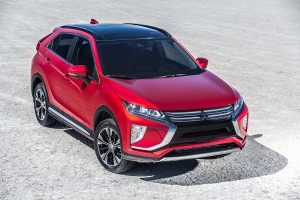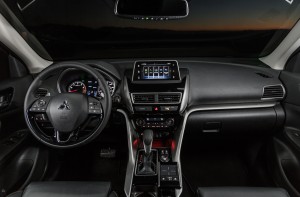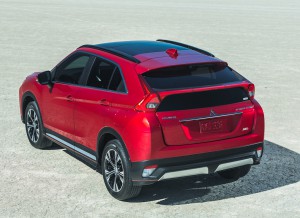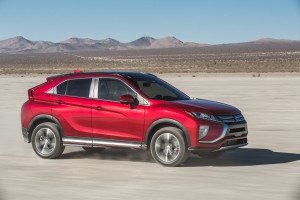
The new Mitsubishi Eclipse Cross sees the company seizing on the rising trend favoring compact crossovers.
The death of small cars has been greatly exaggerated, particularly since they have been morphing into small crossovers that are becoming more and more popular.
Mitsubishi is seizing on this trend with the introduction of the 2018 Mitsubishi Eclipse Cross; a small crossover vehicle with a flat floor so it’s technically a truck but it combines a stylish contemporary exterior with the quickness and maneuverability of a compact car.
The name basically tells the story. The Eclipse was a sporty compact that as popular with buyers years ago while the Cross indicates the vehicle has been completely revised as a crossover for buyers, many of them way too young to remember Mitsubishi’s glory days, who are looking for an affordable vehicle today.
Of course, Mitsubishi has suffered its share of difficulties both prior to and after the recession of a decade ago but it appears to be on the verge of a revival since it became part of the Renault-Nissan alliance last year.
(Mitsubishi gaining sales momentum in U.S. Click Here for the story.)
The Eclipse Cross was developed, however, before Mitsubishi joined the alliance and is the product of the company’s own engineering and design shops and the end result is impressive, suggesting that the Japanese automaker knows a solid foundation for turning out solid vehicles.
On a test drive through the mountains of coastal Southern California, the Eclipse Cross performed admirably. The overall driving dynamics, ride, handling, steering and brakes, all performed efficiently. In fact, the ride, thanks to a well-honed suspension, was particularly impressive as the Eclipse Cross took the curves and undulations on mountain roads with relative ease.
The vehicle’s continuously variable transmission also was impressive. It never missed a beat even during a long climb in the mountainous terrain that has challenged more expensive vehicles. In addition, the air was thicker than normal with the residue from the wildfires hemming in the drive route both to the northwest and the southeast.
A 1.5-liter engine with direct-injection and turbo charging is standard in the Eclipse Cross and the engine delivers a combination of nimble performance and efficiency as well as quick acceleration from a standing start It produces 152 horsepower and 184 lb-ft of torque and features advanced technology such as sodium-filled exhaust valves that outperform 2.0-liter and 2.4 liter engines used in other Mitsubishi products.
The Eclipse Cross is also equipped with Mitsubishi’s proprietary, advanced S-AWC system, which enhances both straight-line stability and cornering performance by precisely controlling the torque supplied to each of the four wheels. The system is effective.
On the inside, Eclipse Cross represents a departure for Mitsubishi. It has moved away the dowdy, all-plastic interiors that had blighted the brand’s image for years. The sporty cockpit is equipped with comfortable seats, a contemporary center stack for audio and navigation and soft materials at key touch points as well as piano black and silver accents.
(Click Here for more details about the Eclipse Cross.)
A 7-inch monitor is used to control the audio system and is able to connect to a smart phone. The system also supports Apple Car Play and Android Auto and is compatible with voice recognition through Google Assistant or Siri. The smart phone link display can also be controlled with a touchpad controller, which allows for a swipe and ease of use while driving.
The Eclipse Cross is also equipped with blind spot warning, lane departure and rear cross-traffic alert and adaptive cruise control.
Another new interior feature for the Eclipse Cross is a full-color Head-Up Display. The HUD provides critical safety messages such as the cruise control setting as well as driver assistance features such as forward collision mitigation warnings, lane departure warnings and paddle shift gear position. The HUD system is standard on SEL models.
Heated rear seats are available on the SEL, while the rear seat has nine positions of recline and can slide forward-backward up to nearly eight inches to balance passenger comfort and cargo capacity. The SEL version of the Eclipse Cross is a panoramic sunroof with dual-pane, large power sliding glass panels with both tilt and slide capability. The front panel also can open up to 17 inches.
Back in the 1990s, Mitsubishi had a reputation for producing stylish designs and the exterior of the 2018 Mitsubishi Eclipse Cross re-establishes the traditions with bold front fascia crisp lines along the vehicles silhouette and a handsome lift gate that all combine to give the vehicle a distinctive appearance.

The interior of the Eclipse Cross represents a significant upgrade over Mitsubishi's previous vehicle's cabin.
Mitsubishi is offer Eclipse Cross in four models: the base ES, LE, SE and top of the line SEL and the standard features include heated side view mirrors, rear spoiler, color multi-information display screen, high-contrast meters, Bluetooth wireless technology, steering wheel audio and phone controls, rearview camera, automatic climate control, power door locks and windows, seven airbags and anti-theft alarm. The starting MSRP for the Eclipse Cross is $23,295 plus a $940 destination charge.
Mitsubishi has traveled a long and winding road over the two decades but the alliance the Renault and Nissan has basically guaranteed Mitsubishi will have steady supply of new vehicles in the years to come, putting a critical support under a brand that many analysts had expected to vanish.
(To see more about Mitsubishi’s three-year plan, Click Here.)
The introduction of the stylish, well-equipped Mitsubishi Eclipse Cross with aggressive pricing is certain to start getting the brand on the shopping lists of more and more consumers.



Based on the big three (Power, Styling, and Price), I predict annual sales of about 7.